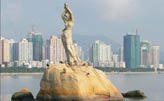Historical and future choice
Updated: 2011-09-08 08:11
By Huang Renwei (China Daily)
|
|||||||||
China's road of peaceful development pursues modernization and harmony at home and cooperation and peace abroad
The White Paper on China's Peaceful Development, issued by the State Council Information Office on Wednesday, is China's authoritative and strategic declaration of its will to adhere to a peaceful development road. It maps out the nation's strategy to realize its long-anticipated modernization as well as its efforts to make contributions to world peace and development.
The white paper first raises the world's concerns over China's development and then answers these concerns by outlining what kind of development road China has chosen and what China's development means for the world.
The white paper goes on to sum up the distinctive character and the connotations of China's peaceful development and its explorations of a socialist path with Chinese characteristics.
A socialist path with Chinese characteristics has a high degree of unity with China's peaceful development and the two are mutual preconditions. This is the key to understanding China's development strategy and development road.
From a domestic perspective, such a road, which is based on the country's national conditions, aims to advance the self-improvement of China's socialist system and realize its modernization drive.
From a world perspective, it tries to connect China's development to world peace and to bring together the interests of the Chinese people with those of the rest of humanity in a bid to push for a harmonious world.
With its peaceful development strategy, China pursues development with a scientific, self-pioneered, open, peaceful and cooperative approach. This is compatible with the trends of the times and remains an irrevocable strategic choice of the Chinese people, as indicated by the many indisputable accomplishments the country has achieved.
The white paper then proceeds to generalize China's peaceful development strategy as the pursuit of development and harmony at home and the pursuit of cooperation and peace with foreign countries.
So far, no other country has set such strategic goals for itself. China has elevated these two aims to the national will and transformed them into the nation's development program and practices. The white paper expounds China's long-term and medium-term development targets as well as the needed conditions and methods for their realization. China's efforts to combine the internal and external environment to better realize its peaceful development strategy is the major transformation and breakthrough the country has achieved in its strategic thinking and strategic moves.
The white paper then expounds China's foreign policy, whose purpose is to safeguard world peace and promote common development. It details a series of moves China has taken to promote a harmonious world, including its efforts to push for the democratization of international relations, efforts to promote balanced development of the world economy and cultural diversity, as well as its efforts to maintain world peace and stability and create a better global environment.
The perspectives that China holds on national interests, security, responsibility and cooperation, as delineated in the white paper, comprehensively reflect the country's basic modes of thinking on contemporary world issues. China insists on connecting the fundamental interests of the Chinese people to those of the world, undertaking deserved responsibilities in international affairs and playing a constructive role in the international system in an endeavor to realize common development, security and lasting peace and prosperity for China and the rest of the world. Such new thinking obviously goes beyond the traditional concepts of international relations advocated by major powers, which focus on the pursuit of hegemony and Cold War confrontation.
The white paper then proves that China's peaceful development road is an inevitable historical and future choice through analysis of its traditional cultures, basic national conditions and the themes of the times. The concept of "peace but not uniformity" that is deeply embodied in China's traditions, allows the country to learn from other countries with different political systems and at varying development stages and tolerate their differences.
China's development is still on a weak foundation and the country has an enormous population, which decides its modernization drive will be a lengthy and arduous process. In an era of globalization that has brought both opportunities and challenges to all countries and makes them more interdependent, China's peaceful development is not only its own historical and future option but also an irreversible global trend.
The final part of the white paper, the universality of peaceful development is elevated to a world height and emphasizes that China is by no means alien to the international society and its development is not a self-isolated task. China needs understanding and support from the outside world, it says. China's rapid development has made more and more countries recognize that its peaceful development road will integrate it more into the international community and offer more opportunities to other world members.
The author is deputy director of the Shanghai Municipal Academy of Social Sciences.











